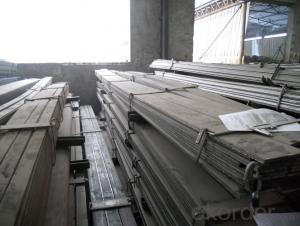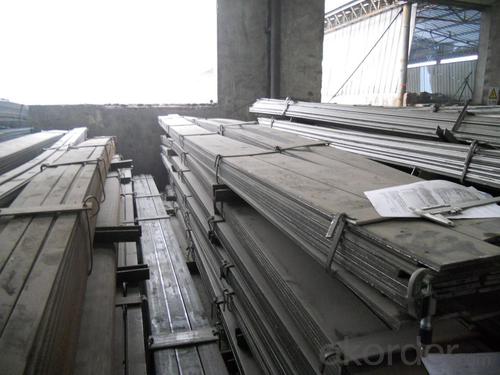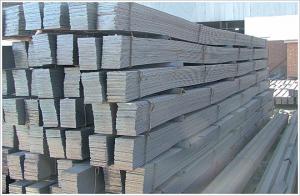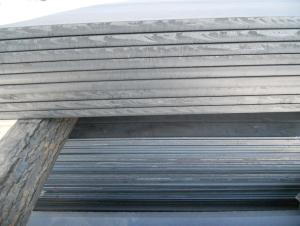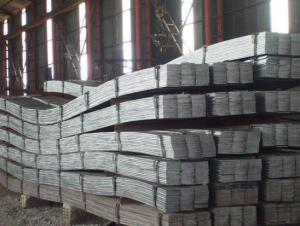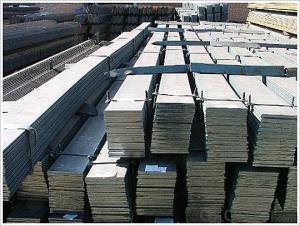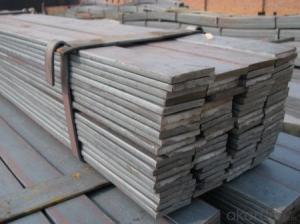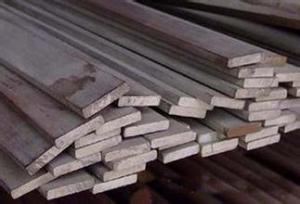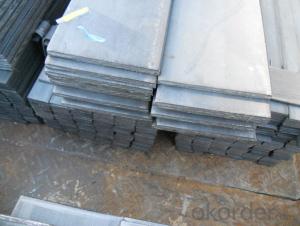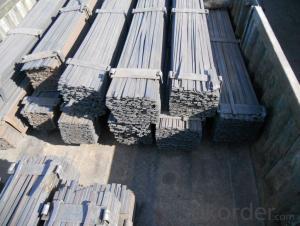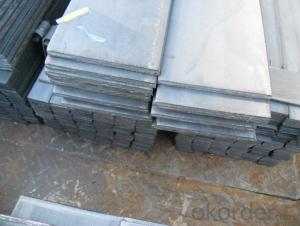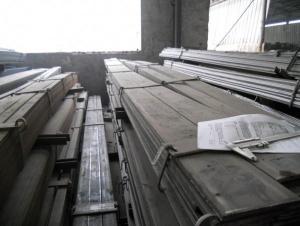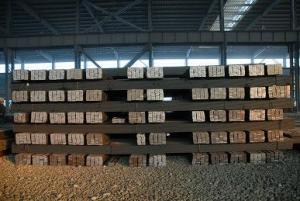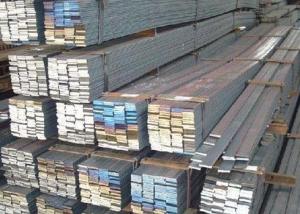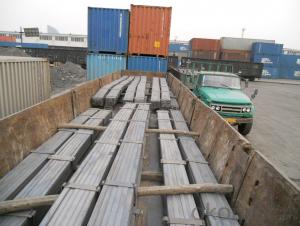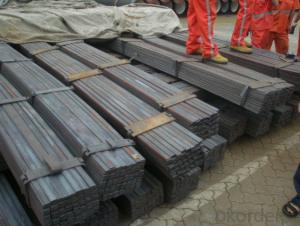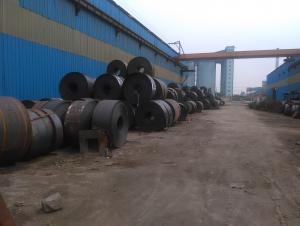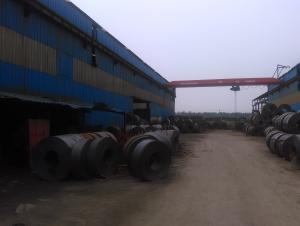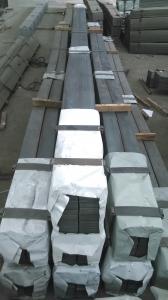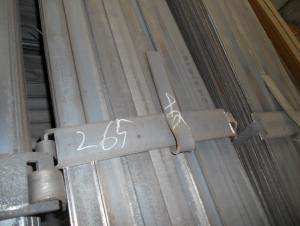HOT ROLLED FLAT BAR
- Loading Port:
- China Main Port
- Payment Terms:
- TT OR LC
- Min Order Qty:
- -
- Supply Capability:
- -
OKorder Service Pledge
OKorder Financial Service
You Might Also Like
Specifications of MS Channel:
1.We supply high quality MS Channel at reasonable price, including Chinese standard, Japanese standard and so on.
Standard | GB/JIS |
Material Grade | Q235,SS400 |
Technique: | Hot Rolled |
Sizes as per chinese standard: | 50*37*4.5mm - 300*89*11.5mm |
Sizes as per japanese standard: | 50*25*3mm – 200*80*7.5mm |
Length: | 6meter, 9meter, 12meter |
Note: 1.we are also competent to provide our customers other MS Channel based on other sizes according to customer’s requirements.
2. The length of our ms channel could be cut into other meters as per customer’s requirements. For example, the channel in 6meters could be cut into 5.8meters in order to be fit in the 20ft container.
2. The detailed sections of MS Channel as per GB standard.are shown in the table-1:
GB U CHANNEL | Standard | Sectional | Dimension |
| Mass: |
| (mm) | (mm) | (mm) | (mm) |
|
50X37 | 50 | 37 | 4.50 | 7.0 | 5.438 |
63X40 | 63 | 40 | 4.80 | 7.5 | 6.634 |
80x43 | 80 | 43 | 5.00 | 8.0 | 8.045 |
|
|
|
|
|
|
100x48 | 100 | 48 | 5.30 | 8.5 | 10.007 |
120x53 | 120 | 53 | 5.50 | 9.0 | 12.059 |
140x58 | 140 | 58 | 6.00 | 9.5 | 14.535 |
140x60 | 140 | 60 | 8.00 | 9.5 | 16.733 |
|
|
|
|
|
|
160x63 | 160 | 63 | 6.50 | 10.0 | 17.240 |
160x65 | 160 | 65 | 8.50 | 10.0 | 19.752 |
|
|
|
|
|
|
180x68 | 180 | 68 | 7.00 | 10.5 | 20.174 |
180x70 | 180 | 70 | 9.00 | 10.5 | 23.000 |
|
|
|
|
|
|
200x73 | 200 | 73 | 7.00 | 11.0 | 22.637 |
200x75 | 200 | 75 | 9.00 | 11.0 | 25.777 |
|
|
|
|
|
|
220x77 | 220 | 77 | 7.00 | 11.5 | 24.999 |
220x79 | 220 | 79 | 9.00 | 11.5 | 28.453 |
|
|
|
|
|
|
250x78 | 250 | 78 | 7.00 | 12.0 | 27.410 |
250x80 | 250 | 80 | 9.00 | 12.0 | 31.335 |
250x82 | 250 | 82 | 11.00 | 12.0 | 35.260 |
|
| |
|
|
|
280x82 | 280 | 82 | 7.50 | 12.5 | 31.427 |
280x84 | 280 | 84 | 9.50 | 12.5 | 35.823 |
280x86 | 280 | 86 | 11.50 | 12.5 | 40.219 |
|
|
|
|
|
|
300x85 | 300 | 85 | 7.50 | 13.5 | 34.463 |
300x87 | 300 | 87 | 9.50 | 13.5 | 39.173 |
300x89 | 300 | 89 | 11.50 | 13.5 | 43.883 |
Table-1
3. The chemical composition of HR Channel Steel according to Q235B is shown in Table-2.
Alloy No | Grade | Element(%) | ||||
C | Mn | S | P | Si | ||
Q235 | B | 0.12-0.20 | 0.3-0.7 | ≦0.045 | ≦0.045 | ≦0.3 |
Table-2
Note: we are able to present our customers relevant SGS test report for chemical composition of HR Channel Steel.
4. The mechanical property of HR Channel Steel according to Q235B is shown in Table-3-1 and Table-3-2
Alloy No | Grade | Yielding Strength Point(Mpa) | |||
Thickness(mm) | |||||
≦16 | >16-40 | >40-60 | >60-100 | ||
≧ | |||||
Q235 | B | 235 | 225 | 215 | 205 |
Table-3-1
Alloy No | Grade | Tensile Strength(Mpa) | Elongation After Fracture(%) | |||
| | Thickness(mm) | |||||
≦16 | >16-40 | >40-60 | >60-100 | |||
≧ | ||||||
G235 | B | 375-500 | 26 | 25 | 24 | 23 |
Table-3-2
Note: we are able to present our customers relevant SGS test report for mechanical property of MS Channel as customer’s request.
Applications of MS Channel:
The MS Channel can be applied to construction of warehouses, workshops, sport stadiums and car parks etc.The hot rolled channel steel belongs to carbon structural steel which is applied to in the field of construction and machinery.In details, the hot rolled channel steel is usually used for arch-itechtural structure, and they could be welded in order to support or hang a vari-ety of facilities. They are also usually used in combination with I beam. Generally,the hot rolled channel steel we supply must possess perfect welding property, riveting property and mechanical property and so on.
Package & Delivery of MS Channel:
1.The hot rolled channel steel will be packed in bundle with steel wire at each end of every bundle and color marking in order to help the customer to recognize his goods more easily at sight.
2. And the hot rolled channel steel could be loaded into 20ft or 40ft container, or by bulk cargo.If the weight of each bundle reaches more than 3.5 mt, the loading by break bulk cargo should be choosed.When the weight of each bundle reaches less than 3mt, the loading by container should be choosed.
3.As for the transportaion from mill to loading port, the truck will be usually used. And the maximum quantity for each truck is 40mt.
4.All in all, we could do in accordance with customer's request
- Q: How do you protect steel flat bars from UV radiation or sun damage?
- There are several ways to protect steel flat bars from UV radiation or sun damage. Firstly, one can apply a protective coating to the surface of the bars. A high-quality paint formulated for outdoor use, with UV-resistant properties, is a common option. This will prevent fading or discoloration of the bars. Another effective method is to use a clear sealant or varnish with UV inhibitors. These products create a barrier on the steel's surface, blocking UV radiation and reducing the risk of sun damage. It is important to choose a sealant designed for metal surfaces to ensure maximum effectiveness. In addition to these measures, regular cleaning and maintenance of the steel bars is vital. This involves removing any dirt, dust, or debris that can intensify UV damage. Regular inspections should also be conducted to identify signs of corrosion or deterioration, as these weaken the steel and make it more susceptible to UV damage. Lastly, if the steel bars are exposed to direct sunlight for extended periods, providing shade or cover is recommended. Awnings, canopies, or other protective structures can be used to block or diffuse sunlight, reducing the intensity of UV exposure. By implementing these protective measures, the steel flat bars can be safeguarded against UV radiation and sun damage, preserving their longevity and structural integrity.
- Q: Can steel flat bars be used for making frames or supports for signage?
- Yes, steel flat bars can be used for making frames or supports for signage. Steel flat bars are known for their strength and durability, making them suitable for providing structural support to signage. They can be easily shaped and welded to create custom frames that can securely hold and display signage. Additionally, steel flat bars are resistant to corrosion, making them ideal for outdoor signage applications where they may be exposed to various weather conditions. Overall, steel flat bars are a reliable choice for constructing frames or supports for signage due to their strength, durability, and resistance to corrosion.
- Q: Are steel flat bars suitable for making defense industry equipment or vehicles?
- Yes, steel flat bars are suitable for making defense industry equipment or vehicles. Steel is highly durable and strong, making it an ideal material for applications that require resistance to impact, wear, and extreme conditions. The flat shape of steel bars allows for easy fabrication and assembly into various components and structures, making it versatile for defense industry equipment and vehicles. Steel is also readily available and cost-effective, ensuring efficient production and maintenance of defense equipment. Additionally, steel can be easily customized and modified to meet specific requirements, such as ballistic protection or structural integrity, further enhancing its suitability for defense industry applications.
- Q: Between the MEB and the power distribution cabinet with wire with the flat and why
- How many will do is a box, the basement has the condition to make the ring to spread the flat steel (copper) to take one circle, many places reserve the ground terminal box foundation to attract, the access flat steel belt;
- Q: How do steel flat bars contribute to the sustainability of construction projects?
- Steel flat bars contribute to the sustainability of construction projects in several ways. Firstly, steel is a highly durable and long-lasting material, ensuring the longevity and resilience of the structures built using these bars. This reduces the need for frequent repairs or replacements, thereby minimizing waste and resource consumption. Additionally, steel is 100% recyclable, meaning that at the end of a structure's life cycle, the steel flat bars can be easily recycled and reused in other projects. This helps to conserve natural resources and reduce the environmental impact of construction activities. Finally, steel's strength and versatility allow for more efficient designs, enabling lighter and more sustainable structures with reduced material usage.
- Q: Are steel flat bars suitable for marine environments?
- Steel flat bars can be suitable for marine environments, but it depends on the specific type of steel and the level of exposure to saltwater or other corrosive elements. Stainless steel flat bars, particularly those made from marine-grade stainless steel such as 316 or 316L, are highly resistant to corrosion and are commonly used in marine applications. These stainless steel flat bars have high levels of chromium and molybdenum, which provide excellent resistance to saltwater, humidity, and other corrosive agents found in marine environments. However, not all steel flat bars are suitable for marine environments. Ordinary carbon steel flat bars are prone to corrosion when exposed to saltwater and can quickly deteriorate. If carbon steel is used in marine applications, it needs to be properly protected with coatings or galvanization to prevent corrosion. In summary, stainless steel flat bars, particularly marine-grade stainless steel, are ideal for marine environments due to their excellent corrosion resistance. On the other hand, ordinary carbon steel flat bars should be avoided unless adequately protected to prevent corrosion.
- Q: Are steel flat bars suitable for fabrication of frames or structures?
- Indeed, frames or structures can be fabricated using steel flat bars. Steel, being a robust and long-lasting substance, offers stability and support for diverse applications. These flat bars find widespread use in construction, manufacturing, and engineering ventures. Notably, steel flat bars boast exceptional load-bearing capacity, resistance against bending and warping, and can be effortlessly welded or bolted together to form frames and structures of varying sizes and shapes. Moreover, steel flat bars prove to be economical and easily obtainable in various grades and dimensions, rendering them an adaptable option for fabricating frames or structures.
- Q: What are the common methods of surface finishing for steel flat bars?
- Steel flat bars can be surface finished through several common methods. These techniques aim to improve the steel's appearance, corrosion resistance, and durability. Hot-dip galvanizing is a prevalent method. It involves immersing the steel flat bars in a bath of molten zinc, resulting in a protective coating that prevents rust and oxidation. Electroplating is another technique, whereby a thin layer of metal, such as chromium, nickel, or zinc, is deposited onto the steel's surface. This not only enhances the appearance but also offers protection against corrosion. Powder coating is a popular choice as well. It entails applying a dry powder electrostatically to the steel's surface, which is then cured under heat to create a durable and visually appealing coating. Powder coating provides excellent resistance against corrosion, abrasion, and chemicals. Shot blasting is a mechanical process used to clean and prepare the steel flat bars' surface. It involves blasting small steel shots at high speed, effectively removing rust, scale, and contaminants. This leaves the surface clean, smooth, and ready for subsequent finishing processes like painting or coating. Painting is also commonly employed. Different types of paints, such as epoxy, polyurethane, or enamel, can be applied to the steel's surface. This not only adds corrosion protection but also enhances the appearance. In conclusion, these surface finishing methods for steel flat bars offer various advantages, including corrosion resistance, improved appearance, and enhanced durability. The choice of method depends on the specific requirements and conditions in which the steel flat bars will be utilized.
- Q: Are steel flat bars available in non-standard lengths?
- Yes, steel flat bars are available in non-standard lengths. While standard lengths for steel flat bars are typically 20 feet or 6 meters, many suppliers offer custom cutting services to provide the desired length. This allows customers to order steel flat bars in non-standard lengths according to their specific project requirements. By offering this flexibility, suppliers cater to a wide range of needs and ensure that customers receive the exact length they need for their applications.
- Q: Can steel flat bars be used for manufacturing furniture?
- Yes, steel flat bars can be used for manufacturing furniture. They are commonly used as structural components for creating sturdy and durable furniture pieces. Steel flat bars offer strength, stability, and versatility, making them suitable for various furniture designs and styles.
Send your message to us
HOT ROLLED FLAT BAR
- Loading Port:
- China Main Port
- Payment Terms:
- TT OR LC
- Min Order Qty:
- -
- Supply Capability:
- -
OKorder Service Pledge
OKorder Financial Service
Similar products
Hot products
Hot Searches
Related keywords
